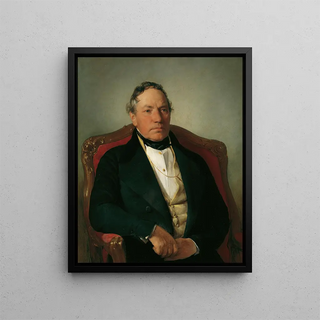Art print | L'industriel Johann Nepomuk Reithoffer - Friedrich von Amerling


View from behind

Frame (optional)
At the heart of the 19th century, Austria experienced an unprecedented artistic effervescence, marked by the emergence of iconic figures who redefine the boundaries of painting. Among these artists, Friedrich von Amerling stands out for his exceptional talent and his ability to capture the essence of his subjects. The art print L'industriel Johann Nepomuk Reithoffer - Friedrich von Amerling bears witness to this mastery, offering a fascinating glimpse into the era and the personality of its model. This painting, which immortalizes an influential industrialist of his time, does not merely depict a businessman; it also evokes the aspirations and tensions of a society in full transformation, where industry and art intersect.
Style and uniqueness of the work
Von Amerling's work is characterized by a realistic style, imbued with delicacy and precision that immerse the viewer in the intimacy of the portrait. The light, subtly orchestrated, sculpts the forms and confers an unprecedented depth to the depiction of the subject. Johann Nepomuk Reithoffer, carefully dressed, appears both majestic and approachable, embodying the entrepreneurial spirit of his era. The details of the clothing, the texture of the fabrics, as well as the thoughtful expression of the model, highlight the artist's skill in conveying complex emotions. This painting, far from being a simple representation, becomes an open window to a time when industrial progress mingled with traditional values, thus revealing the duality of human nature.
The artist and his influence
Friedrich von Amerling, born in 1803, is one of the most respected painters of his time. Trained in Vienna and abroad, he developed a unique style, combining impeccable technique with rare artistic sensitivity. His work, often focused on portraits, reflects not only the individual but also the social and cultural context of his era. Amerling was able to capture the essence of his contemporaries, making his portraits living testimonies of history. His influence endures beyond his own production, inspiring many artists who seek to explore the relationships between the individual and his

Matte finish

View from behind

Frame (optional)
At the heart of the 19th century, Austria experienced an unprecedented artistic effervescence, marked by the emergence of iconic figures who redefine the boundaries of painting. Among these artists, Friedrich von Amerling stands out for his exceptional talent and his ability to capture the essence of his subjects. The art print L'industriel Johann Nepomuk Reithoffer - Friedrich von Amerling bears witness to this mastery, offering a fascinating glimpse into the era and the personality of its model. This painting, which immortalizes an influential industrialist of his time, does not merely depict a businessman; it also evokes the aspirations and tensions of a society in full transformation, where industry and art intersect.
Style and uniqueness of the work
Von Amerling's work is characterized by a realistic style, imbued with delicacy and precision that immerse the viewer in the intimacy of the portrait. The light, subtly orchestrated, sculpts the forms and confers an unprecedented depth to the depiction of the subject. Johann Nepomuk Reithoffer, carefully dressed, appears both majestic and approachable, embodying the entrepreneurial spirit of his era. The details of the clothing, the texture of the fabrics, as well as the thoughtful expression of the model, highlight the artist's skill in conveying complex emotions. This painting, far from being a simple representation, becomes an open window to a time when industrial progress mingled with traditional values, thus revealing the duality of human nature.
The artist and his influence
Friedrich von Amerling, born in 1803, is one of the most respected painters of his time. Trained in Vienna and abroad, he developed a unique style, combining impeccable technique with rare artistic sensitivity. His work, often focused on portraits, reflects not only the individual but also the social and cultural context of his era. Amerling was able to capture the essence of his contemporaries, making his portraits living testimonies of history. His influence endures beyond his own production, inspiring many artists who seek to explore the relationships between the individual and his






